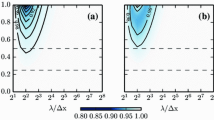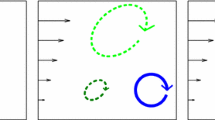Abstract
The effect of numerical differentiation is investigated in the context of evaluating fluctuating velocity and scalar quantities in turbulent flows. In particular, 2-point forward-difference and 3-, 5-, 7-, and 9-point centred-difference schemes are investigated. The spectral technique introduced by Wyngaard (in J Sci Instr 1(2):1105–1108, 1968) for homogeneous turbulence is used to quantify the effects of the schemes. Numerical differentiation is shown to attenuate gradient spectra over a range of wavenumbers. The spectral attenuation, which varies with the order of the scheme, results in a reduction in the measured mean-squared gradients. High-order schemes (e.g. 7- or 9-point) are shown to significantly decrease the attenuation at all wavenumbers and as a result produce more accurate gradients. Hot-wire measurements and direct numerical simulations of decaying homogeneous, isotropic turbulence are found to be in good agreement with the predictions of the analysis, which suggests that high-order schemes can be used to improve empirical gradient estimates. The shape of the probability density functions is also found to be sensitive to the choice of numerical differentiation scheme. The effect of numerical differentiation is also discussed with respect to particle image velocimetry (PIV) measurements of a nominally two-dimensional planar mixing layer. It is found that the relatively low signal-to-noise ratio inherent in typical PIV measurements necessitates the use of low-order schemes to prevent excessive noise amplification, which increases with the order of the scheme. The results of the present work demonstrate that high-order numerical differentiation schemes can be employed to more accurately resolve gradients measured at a given resolution provided the measurements have an adequate signal-to-noise ratio.

















Similar content being viewed by others
References
Antonia RA, Mi J (1993) Corrections for velocity and temperature derivatives in turbulent flows. Exp Fluids 14:203–208
Antonia RA, Browne L, Chambers A (1984) On the spectrum of the transverse derivatives of the streamwise velocity in a turbulent flow. Phys Fluids 27:2628–2631
Antonia RA, Zhu Y, Kim J (1993) On the measurement of lateral velocity derivatives in turbulent flows. Exp Fluids 15:65–69
Antonia RA, Zhu Y, Kim J (1994) Corrections for spatial velocity derivatives in a turbulent shear flow. Exp Fluids 16:411–413
Batchelor GK (1953) The theory of homogeneous turbulence. Cambridge University Press, New York
Burattini P (2008) The effect of the X-wire probe resolution in measurements of isotropic turbulence. Meas Sci Tech 19(115405)
Burattini P, Lavoie P, Antonia RA (2008) Velocity derivative skewness in isotropic turbulence and its measurement with hot wires. Exp Fluids 45:523–535
Buxton ORH (2011) Fine scale features of turbulent shear flows. PhD thesis, Imperial College, Prince Consort Road, London, United Kingdom
Buxton ORH, Laizet S, Ganapathisubramani B (2011a) The effects of resolution and noise on kinematic features of fine-scale turbulence. Exp Fluids 51(5):1417–1437
Buxton ORH, Laizet S, Ganapathisubramani B (2011b) The interaction between strain-rate and rotation in shear flow turbulence from inertial range to dissipative length scales. Phys Fluids 23(061704)
Cai J, Tong C (2009) A conditional sampling-based method for noise and resolution corrections for scalar dissipation rate measurements. Phys Fluids 21(065104)
Cai J, Barlow RS, Karpetis AN, Tong C (2010) Noise correction and length scale estimation for scalar dissipation rate measurements in turbulent partially premixed flames. Flow Turb Comb 85:309–332
Chong MS, Perry AE, Cantwell BJ (1990) A general classification of three-dimensional flow fields. Phys Fluids 2:765–77
Christensen KT, Adrian RJ (2002) Measurement of instantaneous Eulerian acceleration fields by particle image accelerometry: method and accuracy. Exp Fluids 33:759–769
Comte-Bellot G, Corrsin S (1966) The use of a contraction to improve the isotropy of grid-generated turbulence. J Fluid Mech 25(4):657–682
Corrsin S (1964) Further generalization of Onsager’s cascade model for turbulent spectra. Phys Fluids 7:1156–1159
Donzis DA, Yeung PK, Sreenivasan KR (2008) Dissipation and enstrophy in isotropic turbulence: Resolution effects and scaling in direct numerical simulations. Phys Fluids 20(045108):1–16
Elsinga GE, Marusic I (2010) Universal aspects of small-scale motions in turbulence. J Fluid Mech 662:514–539
Ewing D, Hussein HJ, George WK (1995) Spatial resolution of parallel hot-wire probes for derivative measurements. Exp Therm Fluid Sci 11:155–173
Foss JF, Haw RC (1990) Transverse vorticity measurements using a compact array of four sensors. In: Stock DE, Sherif SA, Smits AJ (eds) Symposium on thermal anemometry, ASME-FED, vol 97, pp 71–76
Foucaut JM, Stanislas M (2002) Some considerations on the accuracy and frequency response of some derivative filters applied to particle image velocimetry vector fields. Meas Sci Tech 13:1058–1071
Kim J, Antonia RA (1993) Isotropy of the small scale of turbulence at low Reynolds number. J Fluid Mech 251:219–238
Lavoie P, Avallone G, De Gregorio F, Romano GP, Antonia RA (2007a) Spatial resolution of PIV for the measurement of turbulence. Exp Fluids 43:39–51
Lavoie P, Djenidi L, Antonia RA (2007b) Effects of initial conditions in decaying turbulence generated by passive grids. J Fluid Mech 585:395–420
Lele SK (1992) Compact finite difference schemes with spectral-like resolution. J Comput Phys 103:16–42
Lourenco L, Krothapalli A (1995) On the accuracy of velocity and vorticity measurements with PIV. Exp Fluids 18:421–428
Martín J, Ooi A, Chong MS, Soria J (1998) Dynamics of the velocity gradient tensor invariants in isotropic turbulence. Phys Fluids 10(9):2336–2346
Meyers J, Meneveau C (2008) A functional form for the energy spectrum parametrizing bottleneck and intermittency effects. Phys Fluids 20(065109)
Nobach H, Tropea C, Cordier L, Bonnet JP, Delville J, Lewalle J, Farge M, Schneider K, Adrian RJ (2007) Review of some fundamentals of data processing. In: Tropea C, Yarin J, Foss JF (eds) Springer handbook of experimental fluid mechanics, Springer, chap 22
Pao YH (1965) Structure of turbulent velocity and scalar fields at large wavenumbers. Phys Fluids 8(6):1063–1075
Pope SB (2000) Turbulent flows. Cambridge University Press, Cambridge
Raffel M, Willert C, Wereley S, Kompenhans J (1998) Particle image velocimetry, a practical guide. 2nd edn. Springer, Berlin
Tanaka T, Eaton JK (2007) A correction method for measuring turbulence kinetic energy dissipation rate by PIV. Exp Fluids 42:893–902
Tanaka T, Eaton JK (2010) Sub-Kolmogorov resolution particle image velocimetry measurements of particle-laden forced turbulence. J Fluid Mech 643:177–206
Taylor GI (1935) Statistical theory of turbulence. Proc R Soc Lond Ser A 151(873):421–44
Tennekes H, Lumley JL (1972) A first course in turbulence. The MIT Press, Cambridge
Vétel J, Garon A, Pelletier D (2011) Denoising methods for time-resolved PIV measurements. Exp Fluids 51:893–916
Vieillefosse P (1982) Local interaction between vorticity and shear in a perfect incompressible fluid. J Phys 43(6):837–842
Wallace JM, Foss JF (1995) The measurement of vorticity in turbulent flows. Annu Rev Fluid Mech 27:467–514
Wang G, Barlow RS (2008) Spatial resolution effects on the measurement of scalar variance and scalar gradient in turbulent nonpremixed jet flames. Exp Fluids 44:633–645
Wang GH, Clemens NT, Barlow RS, Varghese PL (2007) A system model for assessing scalar dissipation measurement accuracy in turbulent flows. Meas Sci Tech 18:1287–1303
Worth NA, Nickels TB, Swaminathan N (2010) A tomographic PIV resolution study based on homogeneous isotropic turbulence dns data. Exp Fluids 49(3):637–656
Wyngaard JC (1968) Measurements of small-scale turbulence structure with hot wires. J Sci Instr 1(2):1105–1108
Wyngaard JC (1969) Spatial resolution of the vorticity meter and other hot-wire arrays. J Sci Instr 2(2):983–987
Wyngaard JC (1971) Spatial resolution of a resistance wire temperature sensor. Phys Fluids 14:2052–2054
Zhu Y, Antonia RA (1995a) Effect of wire separation on X-probe measurements in a turbulent flow. J Fluid Mech 287:199–223
Zhu Y, Antonia RA (1995b) The spatial resolution of two X-probes for velocity derivative measurements. Meas Sci Tech 6:538–549
Zhu Y, Antonia RA (1996a) Spatial resolution of a 4-X-wire vorticity probe. Meas Sci Tech 7:1492–1497
Zhu Y, Antonia RA (1996b) The spatial resolution of hot-wire arrays for the measurement of small-scale turbulence. Meas Sci Tech 7:1349–1359
Acknowledgments
RJH and PL would like to acknowledge the financial support of the Natural Sciences and Engineering Research Council of Canada and the Ontario Government. BG and ORHB acknowledge financial support from EPSRC. The authors would also like to thank Dr. Burattini for kindly providing access to his DNS data.
Author information
Authors and Affiliations
Corresponding author
Rights and permissions
About this article
Cite this article
Hearst, R.J., Buxton, O.R.H., Ganapathisubramani, B. et al. Experimental estimation of fluctuating velocity and scalar gradients in turbulence. Exp Fluids 53, 925–942 (2012). https://doi.org/10.1007/s00348-012-1318-0
Received:
Revised:
Accepted:
Published:
Issue Date:
DOI: https://doi.org/10.1007/s00348-012-1318-0




